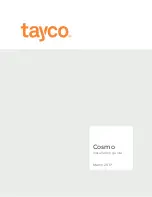
FXAlg #960: 3 Band Enhancer
Algorithm Reference-160
FXAlg #960: 3 Band Enhancer
3-band spectral modifier
Allocation Units:
2
The 3 Band Enhancer modifies the spectral content of the input signal by boosting existing spectral content, or
stimulating new content. First, the input is non-destructively split into 3 frequency bands using 6 dB/oct hipass and
lopass filters. The high and mid bands are separately processed to add additional high-frequency content by using
two nonlinear transfer functions. The low band is processed by a single nonlinear transfer to enhance low-frequency
energy. Each band can also be separately delayed to sample accuracy and mixed back together in varying amounts.
One sample of delay is approximately equivalent to 20 microseconds, or 180 degrees of phase shift at 24 kHz
sampling rate. Using what we know about psychoacoustics, phase shifting or delaying certain frequency bands
relative to others can have useful effects without adding any gain. In this algorithm, delaying the lower bands
relative to higher bands brings out the high-frequency transient of the input signal giving it more definition.
Conversely, delaying the higher bands relative to the lower bands brings out the low-frequency transient
information which can provide punch.
One channel of 3 Band Enhancer
The nonlinear transfers applied to the high and mid bands can be used to generate additional high- and mid-
frequency content when Xfer1 and Xfer2 are set to non-zero values. As the value is scrolled away from 0, harmonic
content is added in increasing amounts. In addition, setting both positive or negative will respectively impose a
dynamically compressed or expanded quality. This type of compression can bring out frequencies in a particular
band even more. The expanding quality is useful when trying to restore transient information. More complex
dynamic control can be obtained by setting these independent of each other. Setting one positive and the other
negative can even reduce the noise floor in some applications.
The low band has a nonlinear transfer that requires only one parameter. Its effect is controlled similarly.
Parameters:
PAGE 1
In/Out
In or Out
Out Gain
Off, -79.0 to 24.0 dB
CrossOver1
17 to 25088 Hz
CrossOver2
17 to 25088 Hz
Crossover
Hi
Mid
Lo
XFer
XFer 1
XFer 1
XFer 2
XFer 2
Delay
Delay
Delay
L Input
L Output
Drive
Mix
Out Gain
















































